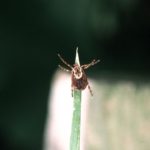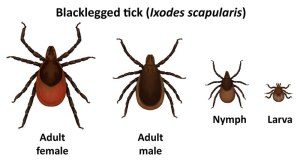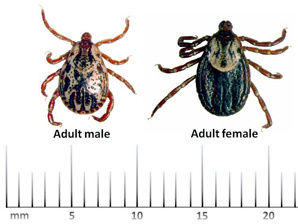General Information

This American Dog tick (Dermacentor variabillis) found on a grass blade is commonly referred to as questing.
Ticks are not insects, they are arachnids. Ticks have two body parts: the cephalothorax and the abdomen. Insects have three body parts: the head, thorax and abdomen. Ticks have eight legs and insects have six legs. Ticks eyes and eight legs are located on the cephalothorax. Insects have their eyes on their head and their six legs are located on the thorax. Ticks do not have wings or antenna, like insects usually have. Ticks have their skeleton on the outside of their body. This is called an exoskeleton. Some ticks also have a scutum. A scutum is a hard plate that covers the tick’s back. It is just like a shield. Ticks are very closely related to mites, spiders and scorpions, which means they are all arachnid. Ticks are medically important arthropods, since they have the ability to transmit Lyme disease, tularemia, Rocky Mountain spotted fever, and ehrlichiosis.
Identification
 The black-legged tick (Ixodes scapularis), also known as the deer tick, is a small tick without white markings. The abdomen of the female appears reddish. It is the principal vector of Borrelia burgdorferi, the Lyme disease spirochete (type of bacterium) in the northeastern United States. Ticks must remain attached to the host for at least 24 hours in order to pass this pathogen to the host. The early signs of the disease usually show up as a rash at the bite site followed by flu-like symptoms. Untreated cases may lead to arthritic conditions and possible neurological problems. Medical care should be sought when a person is bitten by a deer tick or exhibits Lyme disease symptoms
The black-legged tick (Ixodes scapularis), also known as the deer tick, is a small tick without white markings. The abdomen of the female appears reddish. It is the principal vector of Borrelia burgdorferi, the Lyme disease spirochete (type of bacterium) in the northeastern United States. Ticks must remain attached to the host for at least 24 hours in order to pass this pathogen to the host. The early signs of the disease usually show up as a rash at the bite site followed by flu-like symptoms. Untreated cases may lead to arthritic conditions and possible neurological problems. Medical care should be sought when a person is bitten by a deer tick or exhibits Lyme disease symptoms
 The American dog tick (Dermacenter variabilis), is larger than a deer tick and the unengorged female has a whitish shield on its back. This tick readily attaches itself to humans and may carry the organism that causes Rocky Mountain spotted fever, a serious disease that can be transmitted to humans. Symptoms of this disease are headache, fever, and aching muscles 2 to 14 days after tick attachment. Two to three days after the fever starts, a rash develops on the wrists and ankles, spreading to the palms, soles, and trunk of the body. American dog ticks are most likely to be found in open areas with tall grass or brush. All ticks have some stage that is active during the summer. At any time of the year, some life stage of the American dog tick can be found.
The American dog tick (Dermacenter variabilis), is larger than a deer tick and the unengorged female has a whitish shield on its back. This tick readily attaches itself to humans and may carry the organism that causes Rocky Mountain spotted fever, a serious disease that can be transmitted to humans. Symptoms of this disease are headache, fever, and aching muscles 2 to 14 days after tick attachment. Two to three days after the fever starts, a rash develops on the wrists and ankles, spreading to the palms, soles, and trunk of the body. American dog ticks are most likely to be found in open areas with tall grass or brush. All ticks have some stage that is active during the summer. At any time of the year, some life stage of the American dog tick can be found.
Monitoring and Inspection
Landscape management practices designed that make the landscape more inhospitable to primary tick hosts may reduce a tick population. However, these practices alone will not eliminate all ticks and the risk of associated diseases. Therefore, other tick control practices must be integrated with the overall program to reduce the risk of disease. It may be impractical and expensive to institute tick control measures and landscape management practices in all areas of the school grounds. Efforts should be focused on frequently used areas (playground, ball fields, area immediately surrounding the school building, etc.).
A “tick drag” or “tick flag” may be used to determine if ticks are present since ticks are usually found within 18” of the ground. To construct a tick-drag, attach a 3” x 3” white cloth, white heavy flannel, or corduroy material stapled to a dowel and weighted with a second dowel or curtain weights and tie a rope to each end of the wooden dowel. Pull the drag across an area of grass or low brush. At fixed intervals (for example, every 10 meters at high tick density or every 100 yards at low density) examine the cloth and count the number of ticks. This method catches about one out of every ten ticks. Flagging involves brushing higher vegetation with a cloth attached to one end of a pole. Such areas include the under story in wooded areas and brush and shrubs in open areas, along edge habitats, and along property borders.
Nonchemical Control Measures
Personal Protection
- Wear light-colored clothing with long-pants tucked into socks when going into tick-infested areas.
- Educate students, families, and school staff about ticks, tick-vectored diseases, and the proper use of repellents.
- Keep to the center of trails to minimize contact with brush and tall grasses.
- Wash and dry clothing at the highest temperature setting upon returning from a tick-infested area.
- At the end of the day after being outdoors, carefully inspect the entire body. Carefully remove any attached ticks using fine-tipped tweezers to gently grasp the tick as close to the skin as possible. Pull the tick straight upward with steady even pressure. Save the tick for future identification by placing it in a waterproof, crush-proof container with alcohol.
Habitat Modification
- Manage landscape to reduce humidity where ticks are likely to be found.
- Reduce cover for mice. Eliminate wooded, brush-covered habitat, prune lower branches of bushes, clean-up storage areas, woodpiles and junk piles.
- Reduce deer habitat or erect deer-exclusion fencing.
- Rake leaf litter and use wood chips or plant shade-tolerant grass under shade trees to reduce tick abundance.
- Trim trees and brush to open up wooded areas in and around areas of human activity, allowing sunlight to penetrate to reduce moisture and thus reduce tick habitat.
- Keep grass mowed.
- Remove leaf litter, brush, and weeds at the edge of the lawn.
- Restrict the use of ground cover such as creeping ivy in areas frequented by people.
- Discourage rodent activity, by ensuring all openings the size 1/4 inch or larger is sealed up.
- Discourage the use of bird feeders or move at least 100 feet away from school buildings.
- Avoid landscape plantings that attract deer or use deer-exclusion fencing to keep deer off school properties.
- Keep playground equipment away from woodland edges and place them on wood-chip or mulch-type foundation.
- Trim trees and shrubs on the school properties and at the woodland edges to permit more sunlight.
- Create three foot or wider wood chip, mulch, or gravel border between turf and woods.
- Widen woodland trails/walkways to permit trail-users to avoid contact with woody vegetation and tall grasses.
Chemical Control Measures
Insecticides, or as termed for ticks, acaricides, are the most effective way to reduce ticks, particularly when combined with the landscaping changes to decrease tick habitat . These measures provide consistent control, are relatively easy to apply, and are relatively inexpensive. Only small amounts of an acaricide applied at the right time of year are necessary. Chemical intervention should focus on early control of nymphal I. scapularis ticks, the stage most likely to transmit Lyme disease, by spraying once in May or early June. depending on seasonal weather patterns. A fall application in October may be used to control adult blacklegged ticks (or in the spring if no fall application was made). Targeting lawn and woodland edges and perimeter areas near tick “hot-spots” or along the “tick zone” can minimize exposure.
- In parks and school athletic fields, restrict any applications to high-risk tick habitat. Spraying of open fields and lawns is not necessary.
All pesticides sold must be registered with the U.S. Environmental Protection Agency (EPA) and the appropriate state pesticide agency for use within that state.
- The product must be labeled for area-wide tick control (see Table 4). Some products are General Use Pesticides and others are classified as Restricted Use Pesticides for commercial use only, available only to licensed applicators. Some products are labeled for brown dog ticks only or for ticks on surfaces, indoors, as a building foundation or perimeter treatment and are not labeled for use on ornamentals or turf. Check the label and ask for assistance. A licensed commercial applicator often will have a preferred acaricide that is used most frequently.
Evaluation Methods
Use a tick drag, or flag if appropriate, to sample area for ticks after treatment.
For more information on ticks https://tickapp.tamu.edu/
